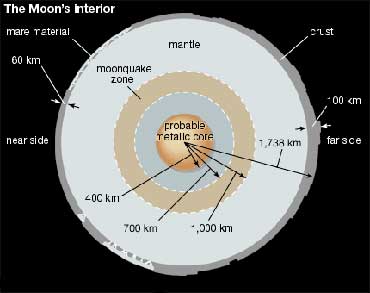Source: NASA
10-19-2007 11:59
 |
The moon, like Earth, has three interior zones -- crust, mantle, and core. However, the composition, structure, and origin of the zones on the moon are much different from those on Earth.
Most of what scientists know about the interior of Earth and the moon has been learned by studying seismic events -- earthquakes and moonquakes, respectively. The data on moonquakes come from scientific equipment set up by Apollo astronauts from 1969 to 1972.
Crust
The average thickness of the lunar crust is about 43 miles (70 kilometers), compared with about 6 miles (10 kilometers) for Earth's crust. The outermost part of the moon's crust is broken, fractured, and jumbled as a result of the large impacts it has endured. This shattered zone gives way to intact material below a depth of about 6 miles. The bottom of the crust is defined by an abrupt increase in rock density at a depth of about 37 miles (60 kilometers) on the near side and about 50 miles (80 kilometers) on the far side.
Mantle
The mantle of the moon consists of dense rocks that are rich in iron and magnesium. The mantle formed during the period of global melting. Low-density minerals floated to the outer layers of the moon, while dense minerals sank deeper into it.
Later, the mantle partly melted due to a build-up of heat in the deep interior. The source of the heat was probably the decay (breakup) of uranium and other radioactive elements. This melting produced basaltic magmas -- bodies of molten rock. The magmas later made their way to the surface and erupted as the mare lavas and ashes. Although mare volcanism occurred for more than 1 billion years -- from at least 4 billion years to fewer than 3 billion years ago -- much less than 1 percent of the volume of the mantle ever remelted.
Core
Data gathered by Lunar Prospector confirmed that the moon has a core and enabled scientists to estimate its size. The core has a radius of only about 250 miles (400 kilometers). By contrast, the radius of Earth's core is about 2,200 miles (3,500 kilometers).
The lunar core has less than 1 percent of the mass of the moon. Scientists suspect that the core consists mostly of iron, and it may also contain large amounts of sulfur and other elements.
Earth's core is made mostly of molten iron and nickel. This rapidly rotating molten core is responsible for Earth's magnetic field. A magnetic field is an influence that a magnetic object creates in the region around it. If the core of a planet or a satellite is molten, motion within the core caused by the rotation of the planet or satellite makes the core magnetic. But the small, partly molten core of the moon cannot generate a global magnetic field. However, small regions on the lunar surface are magnetic. Scientists are not sure how these regions acquired magnetism. Perhaps the moon once had a larger, more molten core.
There is evidence that the lunar interior formerly contained gas, and that some gas may still be there. Basalt from the moon contains holes called vesicles that are created during a volcanic eruption. On Earth, gas that is dissolved in magma comes out of solution during an eruption, much as carbon dioxide comes out of a carbonated beverage when you shake the drink container. The presence of vesicles in lunar basalt indicates that the deep interior contained gases, probably carbon monoxide or gaseous sulfur. The existence of volcanic ash is further evidence of interior gas; on Earth, volcanic eruptions are largely driven by gas.
Editor:Yang Jie
